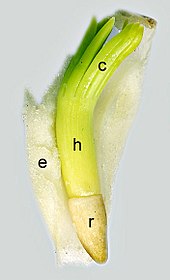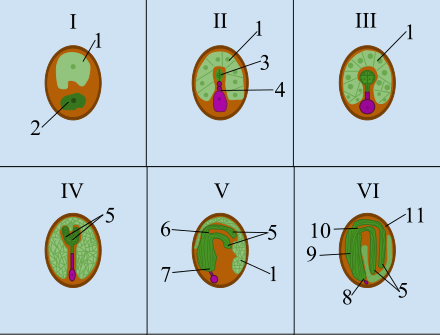Embryo (botany)

In plants, the embryo or seedling is the germ that develops from the fertilized egg cell ( zygote ) and is still nourished by the mother plant. All plants that form an embryo are grouped together as embryophyta .
Research history
The first description of the plant embryo was provided by Giovanni Battista Amici in 1824. He assumed that the embryo emerges from a "germinal vesicle" (egg cell) in the embryo sac and that the pollen tube that penetrates the embryo sac only stimulates the development of the embryo. In contrast, Matthias Jacob Schleiden postulated in 1836 that the embryo emerges from the tip of the pollen tube. Both views found further supporters, and a lively debate ensued until Wilhelm Hofmeister stated in several publications from 1847 to 1861 to the general conviction that Amici's interpretation was correct. It was not until 1884 that Eduard Strasburger described the fusion of the pollen tube with the embryo sac ( syngamy ), thereby refuting both Amici's and Schleiden's hypotheses.
Different types

Seed coat phase I - zygote stage after double fertilization . Phase II - Proembryo stage: the zygote divides into the proembryo and the suspensor. Phase III - spherical stage. Phase IV - cardiac stage. Phase V - Torpedo stage: the radicula takes on a torpedo shape. Phase VI - cane stage: mature embryo.
In the case of mosses and ferns , the embryo continues to develop. In the seed plants , the embryo enters a resting stage in the seed , so it can be clearly distinguished from other growth stages. The development of the embryo from the zygote to the final shape in the semen is called embryogenesis or embryogeny.
According to the orientation, there are two types:
- endoscopic embryos have a scion pole that is directed inwards. They occur in the seed plants and most fern plants.
- In exoscopic embryos, the inward-facing cell becomes the foot, the outer one develops into the sprout pole and then into the sporangium . Exoscopic embryos occur in mosses and horsetail .
Structure in the seed plants
The finished embryo of the seed plants usually consists of the following parts:
- The suspensor pushes the developing embryo from the micropyle into the nutrient tissue ( endosperm ). The connection between suspensor and actual embryo consists of one or more cells and is called the pituitary gland . Suspensor and pituitary gland are usually no longer recognizable in the ripe semen.
- The cotyledons or cotyledons are available in different numbers.
- The hypocotyl is the section of the shoot that connects the cotyledons with the radicle.
- The epicotyl is the section of the shoot that lies between the cotyledons and the next following leaves, the primary leaves.
- The radicle or radicle , the root system .
- The plumula (shoot bud) lies between the cotyledons or next to the single cotyledon and is the axis meristem with the first leaf systems.
Polyembryony
In seed plants with several archegonia per ovule , several embryos can develop (polyzygotic polyembryonia ). Usually only one of them develops into a mature embryo, so that the mature seed contains only one embryo.
literature
- Gerhard Wagenitz : Dictionary of botany. The terms in their historical context. 2nd, expanded edition. Spektrum Akademischer Verlag, Heidelberg / Berlin 2003, ISBN 3-8274-1398-2 , p. 92 f.
Web links
Individual evidence
- ↑ BM Johri (ed.): Embryology of Angiosperms. Springer, Berlin / Heidelberg / New York / Tokyo 1984, p. 377.